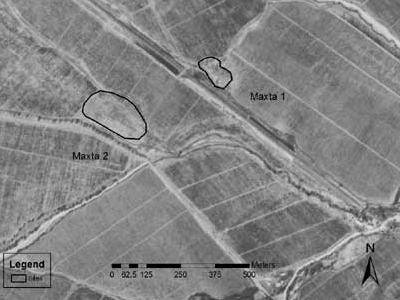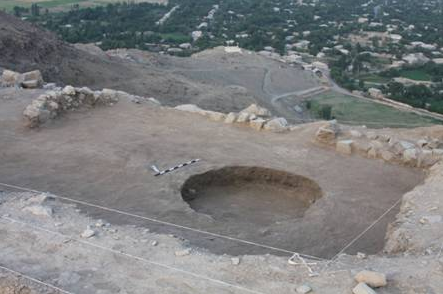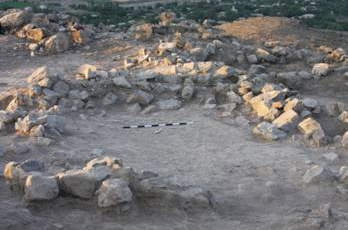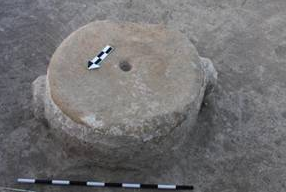The 2011 season gave us an opportunity to study all of the pottery excavated from 2008-2011.
The ceramics from Oğlanqala span all five periods of occupation, but it can sometimes be difficult to distinguish the remains of one period from that of another, due to extensive mixing during construction activities. This means that stratigraphy is not always a good guide for reconstructing the pottery chronology. Period IV storage jar sherds with their arrow-moulded decoration and occasional cuneiform inscriptions, for instance, were found in almost every context. They were unfortunately never found in a context that could be securely dated to the period in which they were made and used. These are very large and heavy pieces of pottery and could not have been washed down a slope; they must have been collected and used as part of the deliberate filling of the citadel area. In the Period II houses area, one large Period IV storage jar sherd was found lying on the floor of Structure 2, where it may have been collected and used as some type of tool. It is possible to tentatively identify a limited number of types with the Period II occupation based on the relative frequency of their occurrence in the Houses area or in Operation C of the 2008 season both of which were firmly dated to Period II. However it is more than likely that sherds from Period III which must have been scattered about the site when these houses were built were also incorporated into the remains of these areas. Comparisons with other sites are also difficult. Pottery from the late Iron Age through the Classical period in the Caucasus, Iran and Eastern Anatolia shows a great degree of continuity, and there are very few stratified sites with published pottery to refine these sequences.
Period V pottery has been found in surface collection prior to excavation and in two areas on the main mound, within the mudbrick platform associated with the northern fortifications and in small quantities at the citadel. We have not isolated period V phases of either of these constructions, rather it seems likely that these older sherds were incorporated into later building materials. The best collection of in situ period V pottery comes from the kurgan excavation. Period V pottery is generally made of gray-black wares, often with burnishing and occasional incised designs. At the kurgan, a plate form was particularly common, as were spouted jars and false handles, of types well-known within the Xocalı-Gedebey sequence and from Iron II contexts in Iran (Figure 14).1
There were no in situ deposits from Period IV, but much of the pottery from the site has close parallels to other sites of this date. The most recognizable Period IV sherds come from very large storage jars or pithoi, with diameters of over a meter and vessel wall thickness of up to 20 cm with distinctive arrow molding (Figure 15). This molding has no exact parallel at any other published site of this period, although molding of various other patterns is always found on Urartian pithoi where it serves to hide the join between the rim and the body.2 As at Urartian sites of this period, four of the cuneiform inscriptions from the site were also impressed on sherds from these storage jars.3 It is tempting to interpret the arrow motif as deliberately echoing the cuneiform wedges. If writing at Oğlanqala was a borrowed expression of the prestige of neighboring elites then the use of this motif may have emphasized this local claim to power. Other Period IV ware types include imported “Palace Ware,” red polished ware and brown mottled ware, all of which have good parallels elsewhere. Other forms like simple rim bowls, plain flaring rim jars and club-rim jars may also date to this period.
Pottery from Period III is the hardest to identify, due to the unfinished nature of the citadel during this period and a lack of good parallels from nearby sites. In spite of the extremely well defined historical sequence of the Achaemenid Empire and the relative abundance of sites of the period, it has remained difficult to precisely isolate an Achaemenid ceramic assemblage. At Oğlanqala, there are few discrete loci that can be assigned to Period III. The identification of forms with this period rests almost exclusively on stylistic criteria and comparison to other sites, rather than on stratigraphy. Ceramics can be distinguished primarily by a number of distinctive forms in a grit tempered pink buff ware with a light red to pink buff slip. This was the most common ware at Oğlanqala and continued into Period II, but certain forms can probably best be associated with the Achaemenid period. These include carinated bowls, a type that is found across the Achaemenid empire from Pakistan to Sardis in Western Anatolia, shallow bowls with out-turned and in-turned rims, jars with moulded handles, and an imported zoomorphic handle (Figure 16). 4 Triangle ware, a painted ware that occurs across Iran and the Southern Caucasus in the late Iron Age, may be associated with either Period III or Period II (Figure 16). This painted form occurs in a Period III context at the citadel, but in a Period II context in one of the houses. It is most common in surface collections, so only further excavation will reveal its complex distribution.
Period II (200 B.C.E.-100 C.E.)
Our many stratified Period II contexts in the citadel pits and the houses make it easier to identify pottery of this period, although reuse of earlier sherds and poor preservation hamper these efforts. In the citadel area when it was possible to isolate the large Period II cooking pits, they contained primarily cooking pots, which tend to be so similar through time that they are not very useful for identifying period-specific types. In addition, the continuity of forms and wares from Period III to Period II makes it difficult to isolate discrete assemblages without a stratified sequence. It is nonetheless possible to identify certain forms with the later part of occupation at Oğlanqala. First, a red or orange slipped simple rim bowl with a ring base is probably the most common Period II type (Figure 17: 1-2, 4). The ring base of this vessel is not typical of bowls in Parthian period sites in Iranian Azerbaijan but does occur at Pasargadae and other western Iranian site, and at the late Hellenistic cemetery at Artashat.5 Grooved ledge-rim bowls (Figure 17: 12, 15) with a lid (Figure 17:12) are one of the most common types found on the surface and are probably dated to this period. Folded ridged jar rims found in the late Achaemenid to Parthian Period in south-western and western Iran are also typical of Period II at Oğlanqala (Figure 17: 7, 8, 11).




